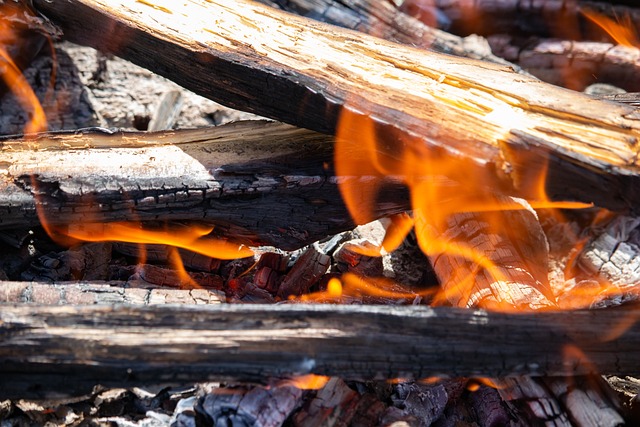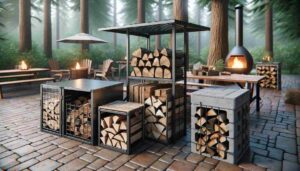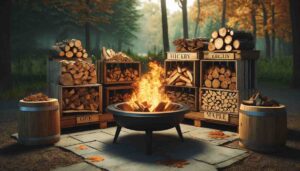Hey there! Are you looking to cozy up to a warm, crackling fire on a chilly evening? If so, you’ve probably wondered about the best firewood to use for a fantastic fire experience. Today, I’m going to delve into the burning question: Is ash wood good firewood? Is ash wood good to burn?
Yes, ash is excellent firewood. It burns efficiently, provides steady heat output, produces minimal smoke, and has low creosote buildup.
In this article, I’ll uncover all the reasons why ash wood is a shining star in the realm of firewood, from its exceptional heat output to its clean burn and minimal creosote buildup. Get ready to stoke the flames of knowledge!
Understanding Firewood Basics
When it comes to building a fire, the choice of firewood plays a crucial role in determining the quality of your fire. So, before I dive into the specifics of ash wood, let’s lay the foundation by understanding some firewood basics.
Firewood is simply wood that is used as fuel for burning in fireplaces, stoves, or outdoor fire pits. It provides both warmth and ambiance, creating the perfect atmosphere for those cozy evenings or gatherings with friends and family.
Now, what makes a good firewood? Here are a few key factors to consider:
- Seasoning: Seasoned firewood refers to wood that has been properly dried to reduce its moisture content. It’s essential to use well-seasoned firewood as it burns more efficiently, produces more heat, and generates less smoke.
- Hardwood vs. Softwood: Firewood is generally classified into two main categories: hardwood and softwood. Hardwoods, such as oak and maple, tend to burn longer, provide more sustained heat, and produce less creosote buildup. Softwoods, like pine and fir, ignite quickly and create a vibrant flame but burn faster and may generate more smoke.
- Density: The density of firewood affects its burn time and heat output. Dense woods, like oak and hickory, have a higher energy content and burn longer. Less dense woods, such as pine and poplar, burn faster but may require more frequent refueling.
Let’s move on to exploring ash wood and whether it holds up as an excellent choice for burning.
Introducing Ash Wood
When it comes to firewood, ash wood is a popular choice among many fire enthusiasts. Ash trees belong to the genus Fraxinus and are native to various regions around the world. This versatile wood has gained recognition for its burning qualities and availability, making it a common sight in firewood stacks.
Ash wood is known for its light to medium brown color and distinctive grain patterns. It is generally categorized into two types: white ash (Fraxinus americana) and green ash (Fraxinus pennsylvanica). Both types offer similar burning characteristics, so you can choose whichever is more readily available in your area.
One of the reasons why ash wood is favored by many firewood users is its abundance. Ash trees are relatively fast-growing and can be found in forests and urban areas alike. This availability makes ash wood a practical choice for those seeking a reliable firewood source.
Not only is ash wood widely accessible, but it also possesses several desirable traits that make it appealing for burning. Its density falls within the range of hardwoods, allowing for a longer burn time compared to softer woods. Additionally, ash wood is known for its ability to produce a steady, sustained heat output.
Let’s delve deeper into its burning characteristics to determine if it’s truly good firewood.
Burning Characteristics of Ash Wood
When it comes to burning firewood, understanding the burning characteristics of different wood types is essential. Let’s take a closer look at the burning qualities of ash wood and see how it stacks up as firewood.
- Heat Output: Ash wood is known for its excellent heat output. It has a high energy content, which means it can provide a substantial amount of warmth when burned. Whether you’re heating up a room or enjoying the cozy ambiance of a fire, ash wood can certainly deliver.
- Burn Time: Ash wood burns relatively slowly compared to softer woods, thanks to its density. This means you won’t need to constantly replenish the fire with new logs, allowing you to enjoy a longer-lasting fire with fewer interruptions.
- Ease of Ignition: Ash wood is moderately easy to ignite. While it may take a bit more effort to get it started compared to softer woods like pine, it generally catches fire quite well with proper kindling and fire-starting techniques.
- Flame Appearance: When burning ash wood, you can expect to see a vibrant and lively flame. The flames dance and flicker, providing a visually appealing fire experience. The vibrant flame can add to the ambiance of your indoor fireplace or outdoor fire pit.
- Aroma: Ash wood produces a pleasant aroma when burned. The scent can vary slightly depending on the specific type of ash wood, but it is generally described as mild and somewhat sweet. The aromatic qualities of ash wood can enhance the overall sensory experience of your fire.
- Crackling Sound: One of the joys of sitting by a fire is listening to the comforting crackling and popping sounds. Ash wood delivers in this regard, providing an enjoyable auditory experience that adds to the cozy ambiance.
Overall, ash wood offers a solid combination of heat output, burn time, and visual and sensory appeal. Its dense composition and favorable burning characteristics make it a reliable and efficient choice for those seeking a satisfying fire experience.
In the next section, I’ll explore the advantages of burning ash wood and why it may be an excellent option for your next fire.
Advantages of Burning Ash Wood
When it comes to selecting firewood, ash wood offers several advantages that make it a desirable choice. Let’s take a closer look at the benefits of burning ash wood:
- Clean and Consistent Burn: Ash wood is known for its clean burn. It produces minimal smoke, which means less chance of smoke-related issues such as soot buildup in your chimney or indoor air pollution. With ash wood, you can enjoy a cleaner and healthier fire experience.
- Low Smoke Emission: Compared to some other wood types, ash wood emits relatively low amounts of smoke when burned. This is particularly beneficial for those who have respiratory sensitivities or live in areas with strict air quality regulations. You can breathe easy while enjoying the warmth and beauty of an ash wood fire.
- Minimal Creosote Buildup: Creosote buildup in chimneys is a common concern when burning firewood. Excessive creosote can lead to chimney fires and reduce the efficiency of your fireplace or stove. The good news is that ash wood produces less creosote compared to softer woods, reducing the need for frequent chimney cleanings.
- Availability and Sustainability: Ash trees are widely distributed and readily available in many regions. This makes ash wood a sustainable firewood option as it can be sourced locally, reducing the carbon footprint associated with transportation.
- Versatility: Ash wood isn’t just limited to firewood use. It has various other practical applications. It is often used in furniture making, flooring, and even for crafting tool handles. So, if you have any leftover ash wood, you can put it to good use in other projects.
Considering these advantages, it’s clear that ash wood is a reliable choice for those seeking a clean, efficient, and sustainable firewood option. Now that I’ve covered the benefits, let’s move on to the next section, where I’ll discuss some considerations to keep in mind when using ash wood for burning.
Considerations When Using Ash Wood
While ash wood offers many advantages as firewood, there are a few considerations to keep in mind to ensure the best burning experience. Let’s explore 5 important factors when using ash wood:
- Seasoning and Moisture Content: Like any firewood, it’s crucial to properly season ash wood before burning it. Freshly cut or green ash wood contains a high moisture content, which can hinder its ability to burn efficiently. Make sure to allow the wood to dry and season for at least 6-12 months in a well-ventilated area before using it as firewood.
- Proper Storage: To maintain the quality of ash wood, proper storage is essential. Store the wood in a dry location, protected from rain and moisture. A well-ventilated woodshed or covered firewood rack can help keep the wood dry and ready for use.
- Size and Splitting: Depending on your specific needs and fireplace or stove size, consider splitting the ash wood into appropriately sized logs. Smaller logs can ignite more easily, while larger logs provide longer burn times. Splitting the wood also helps to increase the surface area for better air circulation and more efficient combustion.
- Ash Wood Density: While ash wood’s density is an advantage in terms of heat output and burn time, it’s worth noting that dense wood can be heavier and harder to handle compared to softer woods. Make sure you’re comfortable handling and stacking the wood properly to prevent any strain or injuries.
- Local Regulations and Restrictions: Before using ash wood or any firewood, it’s essential to familiarize yourself with any local regulations or restrictions regarding wood burning. Some areas may have specific guidelines or restrictions to ensure air quality and safety. Be aware of any bans on burning certain types of wood or restrictions during specific times of the year.
Other Uses for Ash Wood
Ash wood is not only valuable as firewood but also finds application in various other areas. Let’s explore five of the additional uses of ash wood:
- Furniture: Ash wood is highly sought after in the furniture industry. Its appealing grain patterns, durability, and strength make it a popular choice for crafting high-quality furniture pieces. From dining tables to chairs and cabinets, ash wood furniture can add a touch of elegance and natural beauty to your living spaces.
- Flooring: Ash wood is prized for its attractive appearance and durability, making it an excellent choice for flooring. Its light to medium brown hues and distinctive grain patterns can enhance the aesthetics of any room. Ash wood floors can withstand heavy foot traffic and are known for their longevity when properly cared for.
- Tool Handles: Ash wood’s strength, flexibility, and shock-absorbing properties make it an ideal material for crafting tool handles. Whether it’s an axe, hammer, or shovel, ash wood handles can provide a comfortable grip and withstand repeated use.
- Sports Equipment: Ash wood is widely used in the manufacturing of sporting goods. Baseball bats, hockey sticks, and even parts of tennis rackets often utilize the strength and resilience of ash wood. Its combination of stiffness and flexibility makes it a preferred choice in these applications.
- Woodworking Projects: Ash wood’s versatility extends to various woodworking projects. From intricate carvings and sculptures to decorative panels and cabinetry, ash wood provides a canvas for creativity and craftsmanship.
The versatility of ash wood goes beyond its use as firewood, making it a valuable and sought-after material in the woodworking and furniture industries. So, if you have any leftover ash wood from your firewood supply, consider exploring its potential in other projects.
FAQs
FAQs (Frequently Asked Questions) about Ash Wood as Firewood:
Q1: How does the cost of ash wood compare to other firewood types?
A1: The cost of ash wood can vary depending on factors such as availability and local market conditions. Generally, ash wood is considered to be reasonably priced compared to hardwoods like oak or maple.
Q2: Can ash wood be burned when it’s still green or freshly cut?
A2: Burning green or freshly cut ash wood is not recommended. It is important to properly season and dry ash wood before using it as firewood to ensure efficient combustion and avoid excessive smoke production.
Q3: Is ash wood suitable for cooking and grilling?
A3: Yes, ash wood can be used for cooking and grilling. It imparts a mild and pleasant flavor to the food. However, ensure that the wood is properly seasoned and free from any chemical treatments or contaminants.
Q4: Are there any specific safety precautions to consider when using ash wood?
A4: As with any firewood, it is important to follow general fire safety precautions when using ash wood. This includes proper ventilation, using a screen or fireplace doors, and keeping flammable materials at a safe distance from the fire.
Q5: How does the ash wood’s moisture content affect its burning characteristics?
A5: The moisture content of ash wood significantly affects its burning characteristics. Properly seasoned ash wood with lower moisture content burns more efficiently, providing higher heat output and reducing the chances of excessive smoke or creosote buildup.
Q6: Can ash wood be used in wood-burning stoves?
A6: Yes, ash wood is suitable for wood-burning stoves. Its high heat output and burning efficiency make it a popular choice for heating homes and spaces with wood-burning stoves.
Q7: Does the type of ash wood (white ash vs. green ash) affect its burning qualities?
A7: White ash and green ash, two common types of ash wood, share similar burning characteristics. The choice between them usually depends on their availability in your region.
Q8: Can ash wood be burned in fireplaces with glass doors?
A8: Yes, ash wood can be burned in fireplaces with glass doors. The glass doors help control the airflow and prevent sparks from flying out while still allowing you to enjoy the sight of the flames.
Q9: How long does it take for ash wood to properly season?
A9: Ash wood typically takes around 6-12 months to properly season and achieve the desired moisture content for efficient burning. Proper storage and drying conditions are crucial during this period.
Q10: Can ash wood be used in outdoor pizza ovens or smokers?
A10: Yes, ash wood can be used in outdoor pizza ovens and smokers. Its mild flavor and consistent heat make it a suitable choice for cooking and adding smoky flavor to food.
Q11: What is the best firewood, oak or ash?
A11: Both oak and ash are considered excellent firewood choices. They have similar qualities in terms of heat output and burning efficiency. The choice between the two may depend on availability, cost, and personal preference.
Q12: How long does it take for ash wood to season?
A2: The seasoning process for ash wood typically takes around 6-12 months. It’s important to properly dry and store the wood in a well-ventilated area to achieve the desired moisture content for efficient burning.
Q13: Are dead ash trees good firewood?
A13: Dead ash trees can still be used as firewood if properly seasoned. However, it’s essential to inspect the wood for signs of decay, rot, or insect infestation. Dry, dead ash wood can be suitable for burning if it’s free from any structural issues.
Q14: What are the disadvantages of ash wood?
A14: While ash wood has many advantages, one potential disadvantage is its weight and density. Ash wood can be heavier and harder to handle compared to softer woods. Additionally, in some regions, ash trees are susceptible to infestation by the emerald ash borer, which can affect the availability of ash wood.
Always prioritize safety and proper firewood handling practices for an enjoyable and efficient burning experience.
Conclusion
In conclusion, ash wood proves itself to be an excellent choice for burning. Its clean and consistent burn, low smoke emission, and minimal creosote buildup make it a reliable and efficient firewood option. With proper seasoning and storage, ash wood can provide you with a cozy and enjoyable fire experience.
Moreover, ash wood’s availability, sustainability, and versatility make it a valuable resource beyond firewood. It finds application in furniture, flooring, tool handles, and various woodworking projects.
So, the next time you’re preparing for a delightful fire, consider the benefits of using ash wood. Remember to follow proper firewood practices and local regulations for a safe and enjoyable experience. Stay warm, stay safe, and embrace the warmth and beauty of ash wood fires. Happy burning!
Here is the answer to another burning question: Can You Use Pine For Firewood?










